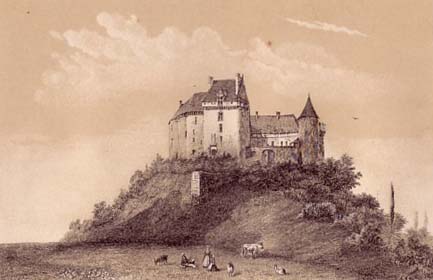 History Château du Bouchet
History Château du Bouchet
- The origin of the building is unknown but a gallo-roman coin
found during excavations carried out in 1921 let us think that
this place was inhabited very early. The castle enjoys a
natural and remarkable location against hostile attacks. It is
built on the highest hill or”button” in the Brenne. From
here, it dominates the whole area until 60 kilometers around.
- The first owner is identified in the 12th century as Guy
Sénebaud, comrade-in-arms of Philip-August. In the 14th
century, during the Hundred-Years War, the castle is acquired
by Pierre de Naillac from a influent family in Le Blanc. The
wife of this new Seigneur du Bouchet, gave the castle to
Artaud d’Ussel , band of marauders leader, allied to the
English who occupied the castle during several years.
- Then, the château du Bouchet has been reconquered by Perreau
d’Oradour relative of de Naillac and in 1451, it is the
property of the family Taveau de Mortemer following to the
marriage between Marie d’Oradour and Geoffroy de Mortemer.
- In 1519, the castle has a new owner again through a marriage
and it is now the property of the well-known family
Rochechouart de Mortemart during three centuries.
Gabriel de Rochechouart de Mortemart has been among the
successive owners was the father of Françoise-Athénaïs,
Marquise de Montespan, the famous mistress of Louis XIV.
- In 1789, Victurnien de Mortemart emigrates and the castle is
confiscated by the revolutionary government. Pierre Huard de
La Vignauderie, “capitaine des chasses” of the Duke of
Mortemart bought back the castle in 1796 and restituated it to
the Duke back to France in 1802.
- Finally,in 1808, the castle has been sold to the mayor of
Rosnay, Victor Hérault de La Véronne whose a descendant,
Chantal Hérault de La Véronne is still the owner .
Architecture of the Château du Bouchet
- The Château du Bouchet, the
“Giant of the Brenne”, is a unique monument because of the
harmony of its architecture covering several centuries. It is
also unique because of its location on the highest hill of the
Brenne.
- The castle was previously a
medieval fortress erected on a hill of red sandstone, typical
stone in the Brenne. It is built around a courtyard and
surrounded by a moat. It is supposed that the fortress was also
protected by one or even two surrounding walls.
- The eldest part of the castle
dates to the 13th century with the two towers at the right of
the gate. These two towers are linked by a chemin de ronde held
up by a curtain wall.
- The keep or “grand donjon” at the
left of the gate has been built in the 14th century. We can
still see grooves of the drawbridge which was the only one
entrance allowing for the passage of pedestrians or horses.
- On the court yard wall of the
keep, there are some corbels which sustained outside wooden
galleries.
- Aside this keep raises the “petit
donjon” or “donjon anglais” built by the English during the
Hundred Years War in the 15th century.
- The other parts of the fortress,
South and West wings, were destroyed by the owner, the Duke of
Rochechouart de Mortemart in the 17th to build a style
Renaissance country residence. Traces of the demolition are
still in evidence on the right side of the “donjon anglais”. The
planned transformation has never been finished probably because
of lack of money. These works consist of the construction
of a dwelling constituted of two perpendicular wings with a long
gallery and a terrace from where we can admire the Brenne and
particularly the lake, the Mer Rouge. A great salon overlooked
on the terrace and the beautiful view through four windows which
were blocked-up in 1798 because of a revolutionary tax, the
“windows tax”. They have been reopened toward 1970.
- The present entrance has been
created in 19th to let carriages come into the castle.
- We wish you a very pleasant visit.
Red
Sea
- This private lake is named Mer Rouge because of the real Red
Sea : when a seigneur du Bouchet, Amaury Sénébaud came back
from the seventh crusade to the Holy Land, he found out that
his lake, named Etang du Bouchet, had the same shape and it is
why he changed its name in Red Sea. With an area of nearly 400
acres, it is the largest lake in the Brenne. Every year around
November, a full month is necessary to empty the lake in order
to fish 15 to 20 tons of mainly carps, pikes and roaches. You
can walk along the lake on a council lane.
- On the opposite side, there is a small chapel, Notre-Dame de
la Mer Rouge, hidden in the wood. Every year, on the 15th of
August, this chapel is the place of a pilgrim as a homage of a
statuette of the Miraculous Virgin found by Amaury Sénébaud in
a tree. This statuette has been burnt during the French Wars
of Religion, then replaced, robbed again and since 1851, a
copy has been kept in the church of Rosnay.”

MAJ 15-04-2012

 History Château du Bouchet
History Château du Bouchet